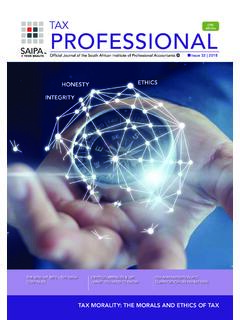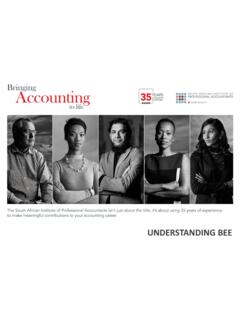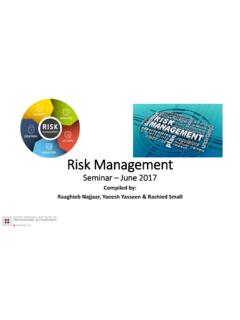Transcription of IFRS for SME’s
1 S E C T I O N 1-S M A L L A N D M E D I U M S I Z E E N T E R P R I S E SIFRS FOR SME SSCOPE OF SECTION 1 Describes the characteristics of SMEs and which type of entities may apply ifrs for SMEsOBJECTIVE OF CPD FOR SECTION 1 Understand what is ifrs for SMEs: Why was it developed The purpose of the framework Who can apply ifrs for SMEs- ifrs for SMEs requirements and Co. act : INTRODUCTION TO ifrs FOR SMES In July 2009 the International Accounting Standards Board (IASB) published the International Financial Reporting Standard ( ifrs ) for Small and Medium-sized Entities (SMEs) Why? SMEs are estimated to represent well over 95 per cent of all companies in both developed and developing countries Difference? The standard was developed to reduce the complexities and burden associated with applying ifrs whilst fulfilling the needs of the users of SME Financial Statements.
2 (type of business and users) : A GLOBAL FINANCIAL REPORTING STANDARD FOR SMES Mainly for comparability Comparability in terms the manner in which events, transactions and conditions are accounted for by different entities for the different users Users: Lenders to multinationals Vendors/suppliers who want to assess financial health of foreign customers/suppliers Rating agencies use info to determine ratings Outside investors of an entity who are involved in day to day Venture capital entities that provide : NEEDS OF USERS OF FINANCIAL STATEMENTS OF SMES Owner managed therefore much fewer users of financial statements and NO PUBLIC ACCOUNTABILITY Main users as discussed above: Lenders to assess liquidity Vendors to make credit and pricing decisions. Customers to decide whether to do business Credit rating agencies to rate SMEs Non managerial shareholders to assess management of the enterprise Short term cash flow ACTION POINT-PAST EVALUATION INSTEAD OF FORWARD LOOKINGH INFO (NON-INVESTMENT) : COST BENEFIT ANALYSIS OF INFORMATION PRESENTED Full ifrs = costly Information reported is dependent on the needs of users If SMEs users would benefit from full ifrs , a cost vs benefit analysis should be performed to assess the : ENTITIES THAT MAY USE ifrs FOR SMES (a) Do not have public accountability, and [Refer: paragraph ]AND (b) Publish general purpose financial statements for external users.
3 WHAT IS PUBLIC ACCOUNTABILITY? (a) its debt or equity instruments are traded in a public market or it is in the process of issuing such instruments for trading in a public market (a domestic or foreign stock exchange or an over-the counter market, including local and regional markets) regardless of the size of the entity, or (b) it holds assets in a fiduciary capacity for a broad group of outsiders as one of its primary businesses. Most banks, credit unions, insurance companies, securities brokers/dealers, mutual funds and investment banks would meet this second criterion ( ).WHAT ARE GENERAL PURPOSE FINANCIAL STATEMENTS? General purpose financial statements are those financial statements that are aimed to provide general financial information to a wide variety of users who are not in a position to demand reports tailored to meet their specific needs.
4 The users include shareholders, creditors and employees IN SUMMARYIf all these requirments are met, ifrs for SMEs can be applied as S is met The entity DOES NOThold assets in a fiduciary capacity for a broad group of outsidersas one of its primary businessThe entity DOES NOTnot have debt or equity traded in a public marketAND neither is it in the process of doing soThe entity DOES publishe general purpose financial statemenetsEXAMPLE 1 Can the following entity apply ifrs for SMEs? Fashion Retailers is an unlisted company primarily involved in the clothing retail industry. Fashion Retailers intends expanding its operations and issues listed bonds on the Bond Exchange of South Africa (BESA).SOLUTION Applyingthedefinitionofpublicaccountabil ityabove,asFashionRetailershasissuedbond sontheBondExchangeofSouthAfrica, : APPLYING ifrs FOR SMES IN SOUTH AFRICA-CO ACT REQUIREMENTS Types of companies Profit (Financial gain) Non-profit (non financial gain, public benefit, 3 or more persons) State-owned companies state-owned enterprise or municipality , SOC Ltd Private companies (MOI) prohibits the offering of securities to the public and transferring equity Min 1 member, propriety limited = (Pty)
5 Ltd Personal liability companies Meets requirmentsof Private co MOI states members are liable in personal capacity, Incorporated Inc Public Companies-Equity can be raised from a public offering and shares can be transferred 1 or more persons Listed-JSE requirement to use full ifrs Unlisted-Can use ifrs for SMEs CO ACT AND ifrs ifrs and ifrs for SME s are permitted All entities apart from public companies, state-owned companies and certain non-profit companies are allowed to apply the ifrs for SMEs. See table below for co. act requirementsCO. ACT CompanyFinancialReportingStandardStateow nedcompaniesFullIFRS,butinthecaseofanyco nflictwithanyrequirementsintermsofthePub licFinanceManagementAct,orotherapplicabl enationallegislation,thelatterprevailsPu bliccompanieslistedonanexchangeFullIFRS, butinthecaseofanyconflictwiththeapplicab lelistingrequirementsoftherelevantexchan ge,thelatterprevailsPubliccompaniesnotli stedonanexchangeFullIFRSorIFRSforSMEs Profitcompanies,otherthanstateownedorpub liccompanies, Profitcompanies,otherthanstateownedorpub liccompanies:(a)whosepublicinterestscore fortheparticularfinancialyearisatleast10 0butlessthan350.
6 Or(b)whosepublicinterestscorefortheparti cularfinancialyearislessthan100, orSAGAAP Profitcompanies,otherthanstateownedorpub liccompanies,whosepublicinterestscorefor theparticularfinancialyearislessthan100, ACT Non-profitcompaniesthatarerequiredinterm sofregulation28(2)(b)tohavetheirannualfi nancialstatementsauditedIFRS,butinthecas eofanyconflictwithanyrequirementsinterms ofthePublicFinanceManagementAct,orothera pplicablenationallegislation,thelatterpr evailsNon-profitcompanies,otherthanthose contemplatedinthefirstrowabove, Non-profitcompanies,otherthanthosecontem platedinthefirstrowabove (a)whosepublicinterestscorefortheparticu larfinancialyearisatleast100,butlessthan 350;or(b)whosepublicinterestscoreforthep articularfinancialyearislessthan100, orSAGAAP Non-profitcompanies,otherthanthosecontem platedinthefirstrowabove,whosepublicinte restscorefortheparticularfinancialyearis lessthan100, itisdeterminebythecompanyPI SCORES What is a PI score?
7 A score used to determine what financial reporting framework can be used The Public Interest Score is calculated as: 1 point for each employee or the average number of employees throughout the year. 1 point per million rand of third party liability. This is the money owed in terms of loans, debentures, and other financing. 1 point for each million rand of turnover during the financial year. If the turnover is half a million rand, score point. 1 point for every individual who, at the end of the year, is known to have a direct or indirect beneficial interest in the company. This will include shareholders, beneficiaries of a trust where a trust is a shareholder and other : SIGNIFICANT ESTIMATES AND OTHER JUDGEMENTS Judgement in establishing if an entity has public accountability or not should be disclosed under significant estimates and E C T I O N 2 CONCEPTS AND PERVASIVE PRINCIPLESS : SCOPE Objectiveof financial statements of small and medium-sized entities (SMEs) qualities that make the information in the financial statements of SMEs useful (Qualitative characteristics) concepts and basic principles underlying the financial statements of SMEs OBJECTIVES FROM CPD To understand the objectiveof financial statements of small and medium-sized entities (SMEs).
8 To understand and apply the qualitative characteristics of ifrs for SMEs. Fundamental and Enhancing To understand concepts and basic principles underlying the financial statements of SMEs To be able to recognise and apply the definitions and recognition criteria of the elements of the financial statement .GENERAL INFORMATION: WHAT IS A CONCEPTUAL FRAMEWORK? The rationale being that a conceptual framework will form a theoretical basis for determining how transactions should be measured and communicated to the users in the financial statements. A conceptual framework from an IASB perspective is a frame of reference for the evaluation of existing ifrs and the development of new standards A well-developed conceptual framework should assist the IASB in developing a global set of financial reporting standards which produces financial statements that are relevant, reliable and comparable to users regardless of where an entity is operating.
9 In summary the conceptual framework addresses the underlying information presented in general purpose financial statements. The objective of this is to facilitate the consistent and logical formulation of ifrs standardsS : OBJECTIVE OF FINANCIAL STATEMENTS OF SMES The objective of financial statements of a small or medium-sized entity is to provide information about the financial position, performance and cash flows of the entity that is useful for economic decision-making by a broad range of userswho are not in a position to demand reports tailored to meet their particular information needs. Financial statements also show the results of the stewardship of management the accountability of management for the resources entrusted to NEEDS OF USERS Information that is useful to users includes: information about the resources of the entity claims against the entity how efficiently and effectively the entity s management and governing board have discharged their responsibilities to use the entity s resources as well as the results of the stewardship of : QUALITATIVE CHARACTERISTICS OF INFORMATION IN FINANCIAL STATEMENTS Qualitative characteristics are the attributesthat make the information provided in financial statements usefulto users.
10 There are 2 types of qualitative characteristics Fundamental : FUNDAMENTAL QUALITATIVE CHARACTERISTICS Primary characteristics Relevance Information is relevant if it is capable of affecting the economic decisions of users Reliability Information is reliable when it is free from material errorand biasand represents that which it either purports to represent or could reasonably be expected to : ENHANCING QUALITATIVE CHARACTERISTICS Understandability( ) Classifying, characterising and presenting information clearly and concisely makes it understandable. F/Ssto be prepared on the assumption that users have a reasonable knowledge of business and economics. Materiality( ) Information is material if its omission will lead to the users of the financial statements making a different decision Substance over form ( ) Transactions and other events and conditions should be accounted for and presented in accordance with their substance and not merely their legal form Prudence ( ) Prudence is the inclusion of a degree of caution in the exercise of the judgements needed in making the estimates required under conditions of uncertainty, such that assets or income are not overstated and liabilities or expenses are not understated Completeness ( ) To be reliable, the information in financial statements must be complete within the bounds of materiality and cost.









